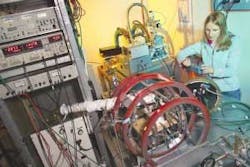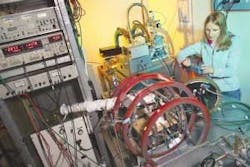Optically pumped gas encoding enables remote optical detection
Optical detection of magnetic resonance images is enabled by the flow of optically polarized xenon gas through this remote detection system assembly being adjusted by doctoral candidate Juliette Seeley in the nuclear magnetic resonance (NMR) research laboratories of Alexander Pines at the University of California–Berkeley and Lawrence Berkeley National Laboratory (LBNL). A continuous flow of the gas from a xenon polarizer collects image data from an encoding probe in a low magnetic field for transport to a highly sensitive gas-spin-exchange optical detector.
Even without a remote detection system, the introduction of optically pumped noble gases can increase the sensitivity of NMR by three to four orders of magnitude. Optical polarization is imparted to the xenon in a two-step process that begins with the transfer of angular momentum from the circularly polarized beam of an 80-W continuous-wave 795-nm-emitting laser-diode array to the spin populations of valence electrons in rubidium gas atoms. The polarization is then transferred to nuclei in the xenon gas through a spin-exchange process (see Laser Focus World, January 2003, p. 36). Remote detection, however, enables physical separation of the two basic NMR steps—encoding and detection—to customize each for the best results. Any NMR-sensitive nucleus with a sufficiently long polarization period can serve as the transfer medium for remote detection. Xenon is particularly well suited for both biosensing and remote detection because it is nontoxic and retains its laser-induced polarization for relatively long time periods on the order of 40 seconds.
While conventional NMR generally involves a tradeoff between encoding and detection efficiency, remote detection alleviates the need for compromise by using the stored magnetic information of a sensor nucleus to carry NMR information from one location to another.1, 2 For instance, in procedures such as magnetic-resonance imaging of the lungs, where the concentration of nuclei of interest in the encoding environment may be dilute, remote detection can enhance sensitivity by concentration of the encoded nuclei for detection within a smaller and optimally designed device. Another scenario might require a low magnetic-field strength in the encoding environment, while calling for a remote high-field-strength magnet at the detector for a higher signal-to-noise ratio.
Customized detection systems that can also be used in remote-detection configurations include superconducting quantum-interference devices (SQUIDs) that provide sensitive detection in low-frequency applications, but may pose difficulty at the encoding end due to geometry restrictions. (Another limitation is a SQUID's sensitivity to magnetic-field pulses, which makes it very difficult to encode and detect in the same place.) Also for xenon-gas carrier spins, optical as opposed to NMR detection can be preferable, providing sensitive monitoring of xenon polarization through contact with the rubidium metal vapor. While various two-location approaches to NMR have been reported previously, the remote detection method reported by the Pines group is distinguished by moving just the data, via polarization of sensor nuclei, rather than moving the sample itself; and by controlled signal transfer and the explicit choice and optimization of separate encoding and detection systems.
REFERENCES
- A .J. Moulé et al., PNAS 100(16) 9122 (Aug. 5, 2003).
- J. A. Seeley et al., J. Magn. Reson. (in press).

